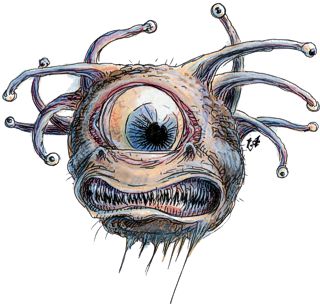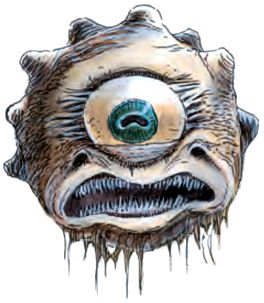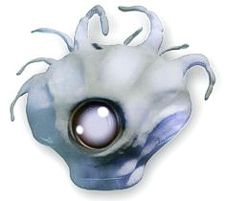

Adventures in space (Lorebook of the Void) • Monstrous Manual

| Beholder (True) | Hive Mother | Orbus | Undead | |
|---|---|---|---|---|
| Tyrannœil (véritable) | Reine-mère | Orbus | Tyramort | |
| Climate/Terrain: | Any remote | Any remote | Any space | Any |
| Frequency: | Rare | Very rare | Rare | Very rare |
| Organization: | Solitary | Solitary | Ship | Solitary |
| Activity Cycle: | Any | Any | Any | Any |
| Diet: | Omnivore | Omnivore | Omnivore | None |
| Intelligence: | Exceptional (15-16) | Genius (17-18) | Non- (0) | Special |
| Treasure: | I,S,T | I,S,T | Nil | E |
| Alignment: | Lawful evil | Lawful evil | Neutral | Lawful evil |
| No. Appearing: | 1 | 1 | 1-6 | 1 |
| Armor Class: | 0/2/7 | 0 | 10 | 0/2/7 |
| Movement: | Fl 3 (B) | Fl 6 (A) | Fl 3 (B) | Fl 2 (C) |
| Hit Dice: | 45-75 hp | 20 | 5-10 HD | 45-75 hp |
| THAC0: | 45-49 hp: 11 50-59 hp: 9 60-69 hp: 7 70+ hp: 5 | 5 | N/A | 45-49 hp: 11 50-59 hp: 9 60-69 hp: 7 70+ hp: 5 |
| No. of Attacks: | 1 | 1 | 0 | 1 |
| Damage/Attack: | 2-8 | 5-20 | Nil | 2-8 |
| Special Attacks: | Magic | Magic | Nil | Magic |
| Special Defenses: | Anti-magic ray | Anti-magic | Anti-magic ray | Anti-magic ray |
| Magic Resistance: | Nil | 5% | Special | Nil |
| Size: | M (4-6’ in diameter) | H (8’ in diameter) | M (4-6’ in diameter) | M (4-6’ in diameter) |
| Morale: | Fanatic (18) | Fanatic (18) | Average (10) | Fanatic (18) |
| XP Value: | 14,000 | 24,000 | 270+ | 13,000 |
The beholder is the stuff of nightmares. This creature, also called the sphere of many eyes or the eye tyrant, appears as a large orb dominated by a central eye and a large toothy maw, has 10 smaller eyes on stalks sprouting from the top of the orb. Among adventurers, beholders are known as deadly adversaries.
Equally deadly are a number of variant creatures known collectively as beholder-kin, including radical and related creatures, and an undead variety. These creatures are related in manners familial and arcane to the traditional
beholders, and share a number of features, including the deadly magical nature of their eyes. The most extreme of these creatures are called beholder abominations.
The globular body of the beholder and its kin is supported by levitation, allowing it to float slowly about as it wills.
Beholders and beholder-kin are usually solitary creatures, but there are reports of large communities of them surviving deep beneath the earth and in the void between the stars, under the dominion of hive mothers.All beholders speak their own language, which is also understood by all beholder-kin. In addition, they often speak the tongues of other lawful evil creatures.
Combat: The beholder has different Armor Classes for different parts of their body. When attacking a beholder, determine the location of the attack before striking (as the various Armor Classes may make a strike in one area, and a miss in another):
| Roll | Location | AC |
|---|---|---|
| 01-75 | Body | 0 |
| 76-85 | Central Eye | 7 |
| 86-95 | Eyestalk | 2 |
| 96-00 | One smaller eye | 7 |
Each of the beholder’s eyes, including the central one has a different function. The standard smaller eyes of a beholder are as follows:
The central eye produces an anti-magic ray with a 140-yard range, which covers a 90 degree arc before the creature. No magic (including the effects of the other eyes) will function within that area. Spells cast in or passing through that zone cease to function.
A beholder may activate the magical powers of its eyes’ at will. Generally, a beholder can use 1d4 smaller eyes if attackers are within a 90 degree angle in front, 1d6 if attacked from within a 180 degree angle, 1d8 if attacked from a 270 degree arc, and all 10 eyes if attacked from all sides. The central eye can be used only against attacks from the front. If attacked from above, the beholder can use all of the smaller eyes.
The beholder can withstand the loss of its eyestalks, each eyestalk/smaller eye having 5-12 hit points. This loss of hit points is over and above any damage done to the central body. The body can withstand two thirds of the listed hit points in damage before the creature perishes. The remaining third of the listed hit points are located in the central eye, and destroying it will eliminate the anti-magic ray. A beholder with 45 hit points will have a body that will take 30 points of damage, a central eye that will take 15 points, while one with 75 hit points will have a body that will withstand 50 points of damage, and a central eye that takes 25 hit points to destroy. Both beholders would have smaller eyestalks/eyes that take 5-12 (1d8+4) points of damage to destroy, but such damage would not affect the body or central eye. Slaying the body will kill the beholder and render the eyes powerless. Destroyed eyestalks (but not the central eye) can regenerate at a rate of one lost member per week.
Habitat/Society: The beholders are a hateful, aggressive and avaricious race, attacking or dominating other races, including other beholders and many of the beholder-kin. This is because of a xenophobic intolerance among beholders that causes them to hate all creatures not like themselves. The basic, beholder body-type (a sphere with a mouth and a central eye, eye-tipped tentacles) allows for a great variety of beholder subspecies. Some have obvious differences, there are those covered with overlapping chitin plates, and those with smooth hides, or snake-like eye tentacles, and some with crustacean-like joints. But something as small as a change in hide color or size of the central eye can make two groups of beholders sworn enemies. Every beholder declares its own unique body-form to be the true ideal
of beholderhood, the others being nothing but ugly copies, fit only to be eliminated.
Beholders will normally attack immediately. If confronted with a particular party there is a 50% chance they will listen to negotiations (bribery) before raining death upon their foes.
Ecology: The exact reproductive process of the beholder is unknown. The core racial hatred of the beholders may derive from the nature of their reproduction, which seems to produce identical (or nearly so) individuals with only slight margin for variation. Beholders may use parthenogenic reproduction to duplicate themselves, and give birth live (no beholder eggs have been found). Beholders may also (rarely) mate with types of beholder-kin.
The smaller eyes of the beholder may be used to produce a potion of levitation, and as such can be sold for 50 gp each.
 The legendary hive mothers are also called the
The legendary hive mothers are also called the Ultimate tyrants
, or just Ultimates
. They are twice the size of typical beholders, and differ in appearance as well.
Their mouths are larger, so large that they can gulp down a man-sized target on a natural die roll of 20. Once swallowed, the prey takes 5-20 points of damage (5d4) each round until it is dead or escapes. The beholder’s mouth is not very deep, so a victim can escape by making a successful attack roll.
The ultimate has no eyestalks, but its magical eyes are protected by hooded covers in the flesh of the creature’s body, so that they cannot be severed. The central eye has 15 hit points.
| Roll | Location | AC | Hit Points |
|---|---|---|---|
| 01-90 | Body | 0 | 20 HD |
| 91-00 | Central Eye | 7 | 15 hp |
The ultimate’s true ability is in controlling the actions of large numbers of beholders and beholder-kin. A hive mother may have 5-10 ordinary beholders under its command, or 5-20 abomination or beholder-kin (see below), which it communicates with telepathically. A nesting hive mother spells disaster for the surrounding region, as it can apparently create a community of beholders, beholder-kin, and abominations. If destroyed, the beholders and beholder-kin will turn on each other, or seek their own lairs.
Hive mothers may be the ancestral stock of the better known beholder, the next step of its evolution, a magical mutation, or a separate species. The reality remains unknown.

The orbus is either a genetically bred or a stunted and immature form of the standard beholder. It is only found in space aboard the tyrant ships of the beholder nations. It is chalk-white and lacks functioning smaller eyes. The central eye is huge and vulnerable, occupying most of the upper body above a small, toothless mouth. This eye has the normal anti-magic properties, but is milky white.
Despite their vulnerability, the orbi are the means by which the beholders travel through space. It is they that can funnel the magical energies of the other beholders into motive force – they are living spelljammer helms. There are 1-5 of them aboard any tyrant ship, and they are located closest to the hive mother, at the deepest point of the shell.
The orbi have their hit points distributed as common beholders: one third for the central eye and two thirds for the body. However, when attacking an orbus, 50% of the hits will strike the central eye, the remainder hitting the body. Both eye and body have the same Armor Class.
 Death tyrants are rotting, mold-encrusted beholders. They may be shriveled, wounds exposing their internal, spherical networks of circular ribs, among the remnants of their exoskeletal plates. All sport wounds, some have eyestalks missing, or a milky film covering their eyes. They move and turn more slowly than living beholders, striking and bringing their eyes to bear last in any combat round.
Death tyrants are rotting, mold-encrusted beholders. They may be shriveled, wounds exposing their internal, spherical networks of circular ribs, among the remnants of their exoskeletal plates. All sport wounds, some have eyestalks missing, or a milky film covering their eyes. They move and turn more slowly than living beholders, striking and bringing their eyes to bear last in any combat round.
An undead beholder can use all the powers of its surviving eyes, just as it did in life. The powers of 2-5 eyes (select randomly, including the central eye) are lost due to injuries or death, and the change to undeath. Although a death tyrant heals
its motive energies through time, it cannot regenerate lost eyestalks or their powers.
Charm powers are lost in undeath. The two eyes that charmed either become useless (60%), or function as weak hold monster effects (40%). A being failing to save against such a hold remains held as long as the eye’s gaze remains steadily focused on them. If the eye is turned on another being, or the victim hooded, or forcibly removed, the hold lasts another 1-3 rounds. Death tyrants are immune to sleep, charm, and hold spells.
If not controlled by another creature through magic, a death tyrant hangs motionless until its creator’s instructions are fulfilled (for example,Attack all humans who enter this chamber until they are destroyed or flee. Do not leave the chamber.
) If no instructions are given to a new
death tyrant, it attacks all living things it perceives. Death tyrants occur spontaneously in very rare instances. In most cases, they are created through the magic of evil beings – from human mages to illithid villains. Some outcast, magic-using beholders have even been known to create death tyrants from their own unfortunate brethren.
Death tyrants have no self-awareness or social interaction; they are mindless servants of more powerful masters. Mindless
is a relative term; the once highly intelligent brains of death tyrants still use eyes skillfully to perceive and attack nearby foes. When a death tyrant is controlled by another being, consider it to have the intelligence of its controller.
Death tyrants are created from dying beholders. A spell, thought to have been developed by human mages in the remote past, forces a beholder from a living to an undead state, and imprints its brain with instructions. Rogue
death tyrants also exist: those whose instructions specifically enable them to ignore all controlling attempts. These are immune to the control attempts of all other beings. Beholders often leave them as traps against rivals.
Human spell researchers report that control of a death tyrant is very difficult. A beholder’s mind fluctuates wildly in the frequency and level of its mental activity, scrambling normal charm monster and control undead spells. A special spell must be devised to command a death tyrant.
Most beholders make saving throws according to their Hit Dice. The typical beholder and undead beholders make saving throws as follows:
| Creature hit points | Saves as |
|---|---|
| 45-49 | 10th level warrior |
| 50-59 | 12th level warrior |
| 60-69 | 14th level warrior |
| 70+ | 16th level warrior |
The beholder races are not limited to the ones presented here. The plastic nature of the beholder race allows many mutations and abominations in the breed, including, but not limited to, the following.
Shunned by other beholders, this is a beholder which has purposely blinded its central eye, so that it might cast spells. It does so by channeling spell energy through an eyestalk, replacing the normal effect with that of a spell of its choice.
These are extremely ancient beholders of godlike intelligence and power. Though they have lost the function of some of their eyestalks, they have more hit points and are able to cast spells. They can supposedly create and control death tyrants.
This ghost-like undead beholder is created by magical explosions.
An undead beholder, it passes on the rotting disease which killed it.
In addition, there are beholders which are in all appearances “normal” but have eyes with alternate magical abilities, such as a detect lie instead of a death ray. Such creatures are usually treated as outcasts by all the beholder and beholder-kin races.
